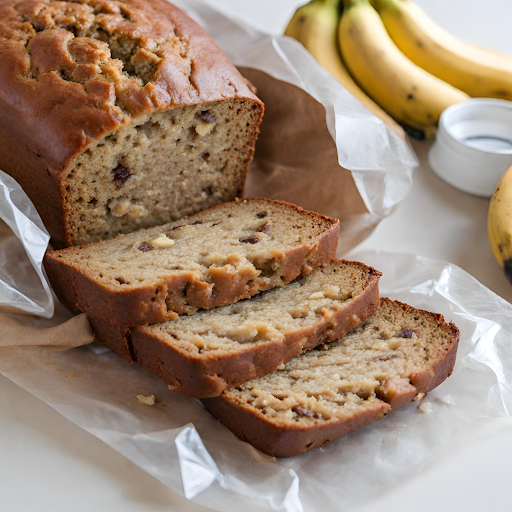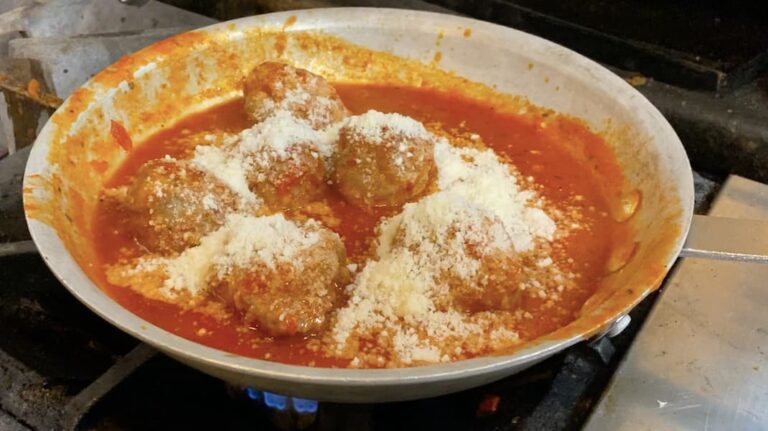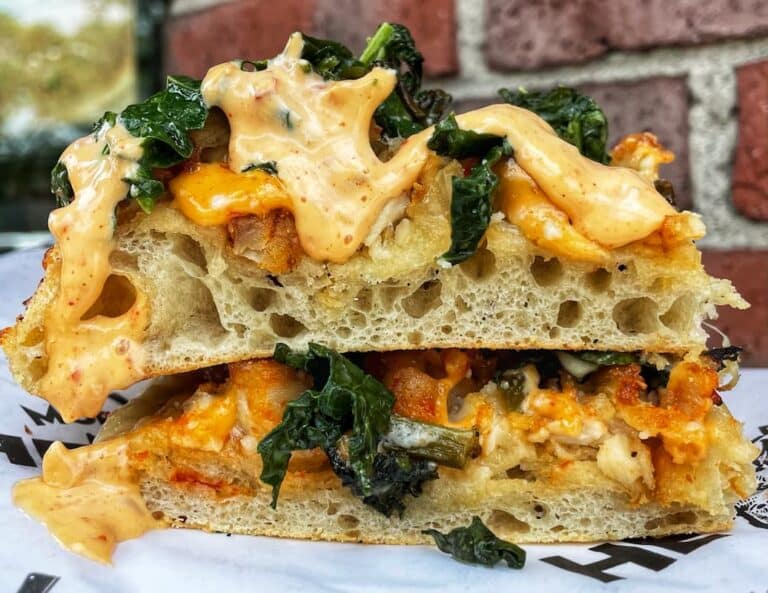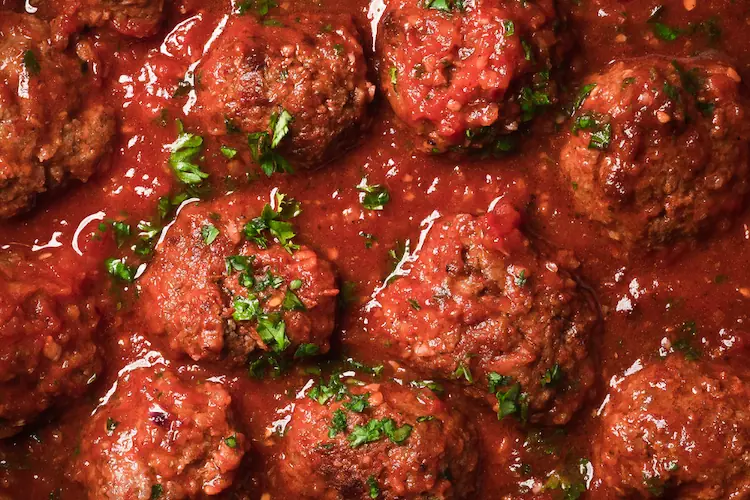Ah, banana bread. I can almost smell the heavenly aroma wafting from my kitchen just by typing the words. Over the past few days, I’ve shared several posts on all things banana bread, and I hope you’ve learned a thing or two!
Let’s face it. Baking is a science. Banana bread isn’t one of those things where you can throw some ingredients together and hope for the best. And if you’re baking it for the first time, you probably have a few questions before getting started.
You’ve probably pored over several banana bread recipes before deciding on the one you want to make. And if you’re still looking for the best banana bread recipe, check mine out here.
In terms of baking, I’ve found that the best way to really nail a recipe is to measure out all my ingredients, both wet and dry. I then read through the step-by-step instructions for any recipe and make sure I know what’s ahead.
When it comes to new bakers, especially those embarking on their first-time banana bread adventure, the fear of a batter gone wrong can dampen that initial excitement. Is it too thick? Too thin? How is this going to look once it’s baked? Trust me, I’ve been there. I’ve stared into a bowl of batter, praying for the best.
Don’t worry, fellow bakers! As a seasoned baker with countless homemade banana bread loaves under my belt (and a few early experiments that, well, let’s just say they weren’t award-winning!), I’m here to be your banana bread batter guru. Today, I’ll delve into achieving that perfect balance—a batter that’s thick yet pourable, the foundation for a truly moist and delicious loaf.

The Science Behind the Batter:
Imagine the batter as the Goldilocks of quick breads. Too much dry ingredients (all-purpose flour, brown sugar, baking soda, baking powder) and you’ll end up with a tough, cake-like result. Too much wet ingredients (mashed bananas, vanilla extract, melted butter, eggs) and your bread will be flat and lacking structure. The key is to achieve a consistency similar to slow-moving honey. It should easily coat the back of a spoon, leaving a visible trail when you run your finger through it. When you tilt the bowl, the batter should flow slowly and smoothly, not rush out in a torrent.
Mastering the Mix
Several factors can influence your batter’s consistency, and understanding them is half the battle:
- Banana Ripeness: Overripe bananas are naturally more moist. If your bananas are sporting a generous amount of brown spots and have a soft texture, that’s fantastic! But if they’re super mushy, consider reducing the wet ingredients by a tablespoon or two in your chosen banana bread recipe.
- Room-Temperature Ingredients: Melted butter adds moisture, so a heavy hand can lead to a thinner batter. Conversely, cold butter won’t incorporate as smoothly. Room-temperature eggs also blend more easily, ensuring a smooth and even batter.
- Mix-Ins: Chocolate chips, chopped walnuts, or dried fruit can thicken the batter slightly. To account for this, reduce the dry ingredients slightly in your recipe.
Mixing with a Gentle Touch:
Once you’ve combined your wet and dry ingredients in a large mixing bowl (a stand mixer or hand mixer can be helpful, but a good old-fashioned whisk works wonders too!), resist the urge to overmix! This develops the gluten in the flour, leading to a tough crumb. Mix just until the dry ingredients are incorporated, and stop as soon as you see no more streaks of flour. This results in a tender crumb.
The Test Kitchen Trick
Unsure about your batter’s consistency? Want a peek into the future? If I’m unsure about how my batter will come out, I’ll sometimes bake a small test mufin or two in muffin tins before committing to the whole loaf. This will give you a sneak peek at the final crumb texture.
Making Adjustments
Thankfully, the banana bread batter is forgiving, and it’s not too hard to fine-tune it. If your batter’s a bit too thick, add a tablespoon or two of milk to thin it out. A too-thin batter can be remedied by sprinkling in a tablespoon of whole wheat flour (a great way to add some extra fiber!) and gently mixing it in.
Batter Consistency’s Impact on the Top of the Loaf:
- Too thick batter: A batter that’s too thick will be difficult to spread in the pan, resulting in an uneven top of the loaf. This can lead to uneven baking and a potentially cracked top. Oh no!
- Too thin batter: On the other hand, a batter that’s too thin will spread excessively, creating a very flat top of the loaf. While this might bake evenly, it might lack the characteristic dome shape of banana bread.
Troubleshooting Tips
- Fixing a peaked top: If your batter seems a bit thick and creates a peaked top after pouring, don’t worry! Gently tapping the pan a few times on the counter will help settle the batter and smooth out the top.
- Fixing a sunken top: If your batter is too thin and the top of the loaf dips in the center during baking, you might have overmixed the batter. Next time, aim for a slightly thicker consistency and avoid overmixing.
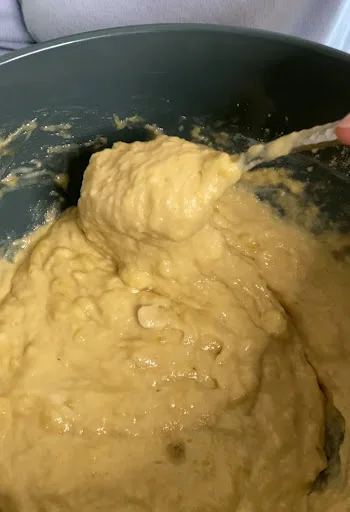
Now You’re Baking Like a Pro!
With these tips and a little practice, you’ll be a banana bread batter master in no time. Here are some additional tips to elevate your banana bread game:
- Invest in measuring cups: Accuracy is key! A detailed ingredient list in your recipe will help you avoid any mishaps.
- Use ripe bananas. Brown spots and a soft texture are your friends for maximum banana flavor. Don’t be tempted by those green beauties on the counter—without the sugar content, they just won’t deliver the same result.
- For the best results, let the loaf cool completely on a wire rack before slicing. Slicing a warm loaf can lead to a crumbly mess.
- Store leftovers in an airtight container (a zip-top bag or a container with a secure lid) on the counter for a day or two, or freeze for longer storage. Wrap the cooled banana bread loaf in plastic wrap or aluminum foil before placing it in the freezer to prevent freezer burn.
The Perfect Banana Bread Baking Process
- Grab your favorite banana bread recipe, gather your basic ingredients (flour, sugar, baking soda, etc.), and a large bowl.
- Preheat your oven to the temperature specified in your recipe (most recipes call for around 350°F) and prepare your loaf pan. Lining the bottom with parchment paper is a great way to ensure easy removal of your perfect loaf later.
- Pour the batter into the prepared pan, smoothing the top with a rubber spatula. For an extra touch of elegance and a delightful textural contrast, you can sprinkle the top with a handful of mini chocolate chips or chopped nuts.
- Bake the loaf according to my recipe’s instructions. The bake time will vary depending on the size of your loaf pan and your oven’s temperament. A toothpick inserted into the center of the loaf and coming out clean is a good indication that your banana bread is done.
- Let the loaf cool completely on a wire rack before slicing. This allows the internal structure to be set correctly, resulting in a clean and even slice.
Beyond the Basics: Experimentation is Key!
The beauty of banana bread is that it’s incredibly versatile. Once you’ve mastered the basic recipe, you can experiment and personalize it to your taste. Here are a few ideas to get your creative juices flowing:
- Spice it Up: Add a pinch of cinnamon, nutmeg, or ginger for a warm and comforting flavor profile.
- Go Tropical: Swap out some of the flour for coconut flour and add chopped pineapple and macadamia nuts for a tropical twist.
- When in Doubt, Add Chocolate: Fold in dark chocolate chips or cocoa powder for a decadent chocolate banana bread experience.
- Make it Mini: Pour the batter into muffin tins lined with paper liners for individual-sized banana bread treats. The bake time will be shorter, so keep an eye on them!
With my tips and a little practice, you’ll be baking perfect loaves of banana bread in no time. Don’t be afraid to experiment, have fun, and, most importantly, enjoy the process! Knowing you created a masterpiece from scratch, there’s nothing quite like the satisfaction of pulling a golden brown, moist banana bread loaf out of the oven. Happy baking!

